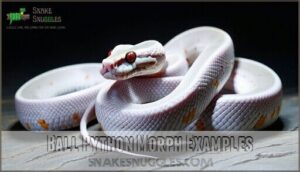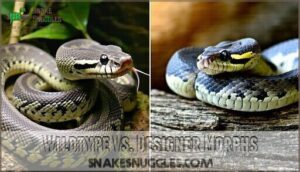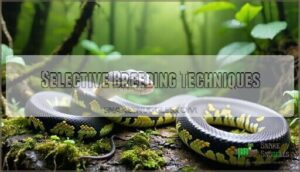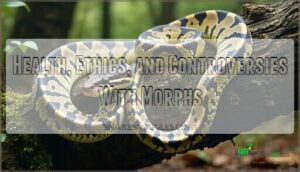This site is supported by our readers. We may earn a commission, at no cost to you, if you purchase through links.
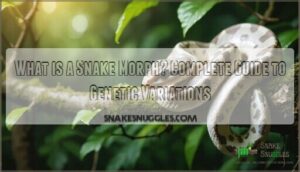
Imagine morphs as nature’s secret art gallery. Each variation carries a heritable trait that follows predictable patterns—you can actually forecast what offspring will look like based on the parents’ genetics.
From albino ball pythons with their creamy whites and bright yellows to piebalds with their random patches of color, these aren’t accidents of nature. They’re genetic blueprints that get passed down reliably. Ball pythons, corn snakes, and boas now come in hundreds of morph combinations, each following specific inheritance rules.
Once you understand the genetics behind these living gems, you unlock the secrets that turn ordinary snakes into stunning works of art.
Table Of Contents
- Key Takeaways
- What is a Snake Morph?
- How Do Snake Morphs Occur?
- Common Types of Snake Morphs
- Breeding, Classification, and Economic Impact
- Health, Ethics, and Controversies With Morphs
- Frequently Asked Questions (FAQs)
- How do morphs affect snake behavior?
- Can inbreeding lead to health issues?
- How do morphs impact snake physique?
- What is the process of creating new morphs?
- How do morphs impact snake reproduction?
- How long do snake morphs live?
- Can morphs reproduce with wild-type snakes?
- Are morphs harder to care for?
- Do morphs have different temperaments?
- Which morphs are best for beginners?
Key Takeaways
- You’re looking at genetic blueprints, not accidents – Snake morphs are reproducible genetic variations that create predictable color and pattern changes through specific gene mutations you can trace and breed for.
- You’ll need to understand inheritance patterns to breed successfully – Dominant genes show up when one parent carries them, recessive genes need both parents to express, and codominant genes blend traits, letting you predict offspring outcomes.
- You can’t ignore the health risks that come with certain morphs – Some popular varieties like Spider ball pythons carry serious neurological issues, while inbreeding practices can compromise your snake’s overall wellbeing and genetic diversity.
- You’re entering a market where genetics drive dramatic price swings – Rare morphs can reach $70,000 while common ones sell for $15, with oversupply and breeding complexity significantly impacting what you’ll pay or earn.
What is a Snake Morph?
Breeders work with specific gene mutations through selective breeding programs, creating incredible visual combinations that showcase nature’s genetic diversity.
These variations result from specific gene mutations that breeders can reproduce through selective breeding to create stunning visual combinations.
Definition of Snake Morphs
Snake morphs are basically genetic variations that show up consistently when you breed certain snakes together. Think of them as nature’s way of creating different color and pattern combinations that you won’t see in wild snakes.
Snake breeding enthusiasts use morph classification systems to identify these variations, which follow established breed standards. Each morph showcases nature’s creativity through predictable genetic expression.
Snake breeding enthusiasts use morph classification systems to identify these variations, which follow established breed standards. Each morph showcases nature’s creativity through predictable genetic expression.
Polymorphism and Genetic Variation
Polymorphism is like nature’s art studio for reptile genetics. When genes mutate, they create stunning color variations by tweaking how traits get expressed and passed down through generations.
Polymorphism unlocks nature’s creative toolkit in reptile genetics. Genetic mutations create natural color variations through altered gene expression and trait inheritance patterns.
Genetic drift influences mutation rates across snake populations, driving evolutionary adaptation. This genetic variation produces the stunning array of color mutations we see today.
Polymorphism ensures species survival while giving breeders endless possibilities to explore fascinating combinations.
How Morphs Differ From Wild-Type Snakes
What sets morphs apart from their wild counterparts? Wild-type snakes display standard colors and scale textures found in nature.
Morphs showcase dramatic genetic variation through altered color patterns, unique eye colors, and modified scale arrangements. These genetic mutations create morph expressions that transform ordinary browns and blacks into striking yellows, whites, and purples.
Selective breeding amplifies these polymorphism effects, producing snakes that look completely different from their wild relatives.
How Do Snake Morphs Occur?
When you’re breeding snakes, you’ll discover that morphs happen through genetic mutations that change how genes express color and pattern traits. These mutations can occur naturally in wild populations, but most exciting morphs you’ll see today come from selective breeding programs where breeders combine different genetic lines to create stunning new variations.
Genetic Mutations Behind Morphs
What makes morphs so fascinating comes down to molecular biology and the stunning variations it creates. When genetic mutations happen, they produce heritable traits that look completely different from what you’d see in wild animals. These mutations don’t happen randomly – they occur at predictable rates and mess with the gene expression pathways that control how colors and patterns show up.
Here’s the basic process in reptiles:
- DNA changes alter the cells that make colors
- Multiple versions of the same trait can exist in one species
- Mutations target melanin and other pigment systems
- Which genes get activated determines what you actually see
The cool thing about reptile genetics is that inheritance follows predictable patterns. This makes it possible for breeders to reproduce specific color morphs through careful genetic planning.
Reptile genetics and traits follow predictable inheritance patterns, making genetics and color morphs reproducible through careful breeding programs.
Natural Vs. Selective Breeding
While genetic mutations occur naturally through genetic drift, you’re likely encountering captive-bred morphs through selective breeding methods. Wild snakes develop variations over generations through species adaptation and natural mutation rates.
Breeders accelerate this process using controlled hybridization and targeted breeding methods. This human intervention creates the stunning genetic variation in reptiles you see today, transforming random mutations into predictable snake breeding and morphs programs that consistently produce desired reptile genetics and traits.
Heritability and Gene Expression (Dominant/Recessive)
When you’re breeding morphs, genetic inheritance follows predictable patterns. Dominant genes always show up in offspring, while recessive genes need both parents carrying them. Codominant genes create blended effects, giving you exciting surprises.
- Dominant traits appear with just one parent carrying the gene
- Recessive genes require both parents to pass the trait
- Codominant genes blend characteristics from both parents
- Gene expression determines which traits actually show up
- Heritability patterns help predict offspring outcomes
Understanding snake genetics lets you plan breeding projects with confidence.
Common Types of Snake Morphs
You’ll encounter three main categories when exploring snake morphs: ball python variations like albino and piebald, morphs from other species such as corn snakes and kingsnakes, and the distinction between naturally occurring wild-type patterns versus designer combinations created through selective breeding.
These classifications help you understand both the genetic foundations and market value of different morph types.
Ball Python Morph Examples
Ball Python morphs showcase stunning color patterns that’ll blow your mind. The Albino morph features striking red eyes and white patches, selling for $300-500. Piebald morphs display large white sections contrasting with normal patterns. Spider morphs create web-like designs but carry neurological risks. Pastel morphs intensify yellow brightness, while Banana morphs show vibrant orange and lavender hues.
These snake genetics demonstrate how morph genetics transforms reptile breeding and pet ownership experiences. Understanding the basics of genetic variation is essential to appreciating the diversity of Ball Python morphs.
Morphs in Other Snake Species
Beyond ball pythons, snake genetics and morphs create stunning variations across species. Corn Snake Morphs showcase vibrant reds and oranges, while Boa Constrictor Patterns display intricate designs.
You’ll find striking diversity in:
- King Snake Variations with bold black and white bands
- Milk Snake Colors ranging from scarlet to pastel hues
- Gopher Morphs featuring unique striping patterns
Reptile breeding has unlocked countless animal variation possibilities across these species.
Wildtype Vs. Designer Morphs
Think of wildtype Ball Pythons as the original recipe – these snakes carry the standard colors and patterns you’d find crawling through African grasslands. Their browns, tans, and basic banding represent thousands of years of natural selection at work.
Designer morphs flip this script entirely. Breeders take different genetic mutations and mix them together through careful pairings, creating snakes that look nothing like their wild cousins. This selective breeding unlocks incredible genetic variation – from pure white leucistics to complex combinations that showcase multiple traits in a single animal.
Designer genetics emerge through selective breeding, combining multiple morphs to create unique color morphs and pattern morphs. These hybridization effects showcase remarkable genetic variation and morph expression possibilities in snake genetics and morphs.
Breeding, Classification, and Economic Impact
When you’re ready to turn your breeding passion into profit, you’ll need to understand how selective breeding techniques create valuable genetic combinations that can fetch hundreds or even thousands of dollars per snake.
The morph market operates on clear classification systems that help you identify dominant and recessive traits, making it easier to predict which pairings will produce the most sought-after color variations.
Selective Breeding Techniques
Successful breeding strategies combine genetic testing with careful morph prediction to reveal stunning color variations. You’ll master reptile breeding techniques through strategic hybridization methods that transform basic genetics into exceptional ball python morphs.
Key selective breeding approaches include:
- Linebreeding techniques – Pairing related snakes to concentrate desirable snake genetics and morphs
- Test breeding – Using proven males with unknown females to determine hidden genetic traits
- Outcrossing methods – Introducing new bloodlines to create novel pattern morphs and combinations
Modern breeders rely on genetic testing to predict outcomes before pairing animals. This scientific approach eliminates guesswork from breeding strategies, letting you focus on creating the next innovative morph combination.
Classification Systems for Morphs
Three main systems organize morphs for you: Morph Typology groups by visual traits, Genetic Coding tracks Trait Inheritance patterns, and Species Classification separates Ball Python Morph variations from other snakes. Color Variation and Pattern Variation categories exist within each system.
Breeding Standards define Codominant Genes versus recessive traits, helping you predict offspring outcomes and maintain consistent morph identification across the hobby.
Market Value and Popularity Among Enthusiasts
Understanding market dynamics reveals Snake Genetics drive dramatic price swings across Collector Communities. Ball Python morphs dominate Pet Retail, with over 32,000 listings creating fierce competition among Breeder Networks.
- Morph Demand fluctuates wildly – rare varieties reach $70,000 while common ones sell for $15
- Market Trends show oversupply crushing prices, forcing "buy one get one" promotions
- Enthusiasts fuel the Reptile Hobby through social media influence and pandemic-driven interest
- Pet Ownership costs vary dramatically based on genetic rarity and breeding complexity
The popularity of certain snake species, such as those with unique color morph traits, markedly impacts their market value.
Health, Ethics, and Controversies With Morphs
Morph breeding opens up incredible color possibilities, but certain genetic traits pack serious health consequences you can’t ignore.
While breeding morphs can create stunning color combinations, you’ll need to understand the serious health risks that come with certain genetic traits.
Some popular morphs like Spider ball pythons carry neurological issues, and inbreeding practices can compromise your snake’s overall wellbeing and genetic diversity.
Genetic Health Risks (e.g., Spider Wobble)
Several morphs carry serious Genetic Disorders that you can’t ignore. Ball Python Spider morphs consistently develop Wobble Syndrome, causing severe Neurological Issues and balance problems. Desert and Caramel Albino morphs face fertility challenges and egg-binding complications.
These Morph Related Illnesses stem from Hereditary Defects in Snake Genetics. Unlike harmless variations like standard Albinism or Leucism, these conditions markedly impact quality of life.
Inbreeding and Genetic Diversity Concerns
Genetic bottlenecks plague the morph breeding world when you’re chasing that perfect Ball Python combination. Inbreeding depression hits hard when breeders repeatedly use the same bloodlines for desired traits like albinism. Here’s what threatens your breeding program:
- Genetic Drift reduces available alleles in small populations
- Linebreeding Risks accumulate harmful recessive genes over generations
- Gene Pool Conservation becomes impossible with limited founder animals
- Hybrid Vigor disappears as genetic diversity shrinks
- Herpetology research shows morphs need outcrossing to maintain health
Smart breeders balance beauty with genetics.
Responsible Breeding and Animal Welfare
Good captive breeding isn’t just about producing pretty snakes—it’s about doing right by the animals first. Before you even think about pairing ball pythons, genetic testing is non-negotiable. You need to know what harmful traits might be lurking in their DNA.
Animal welfare advocates make a solid point: health should always trump profits in morph breeding. The best breeders in the herpetology community get this. They invest in proper care, give their snakes room to actually move around, and keep a good reptile vet on speed dial. That’s what separates quality breeding from backyard operations.
Animal rights advocates emphasize that ball python morph breeding should prioritize health over profits. Quality herpetology and conservation-minded breeders focus on animal care and welfare first.
Frequently Asked Questions (FAQs)
How do morphs affect snake behavior?
Most morphs don’t change behavior, but some create neurological issues. Spider morphs can cause wobble syndrome – head shaking, corkscrewing, and balance problems.
You’ll want to research specific morphs before breeding.
Can inbreeding lead to health issues?
Like rolling the dice with loaded genes, inbreeding can absolutely trigger health issues. You’ll see kinked spines, neurological problems, and weakened immune systems without fresh genetic diversity.
How do morphs impact snake physique?
You’ll notice morphs don’t just change colors and patterns – they can alter body structure too. Some morphs affect head shape, scale texture, and even growth rates, creating snakes with unique physical characteristics beyond typical appearance variations.
What is the process of creating new morphs?
Creating new snake morphs involves selective breeding, where you’ll cross two different morphs to combine their genetic traits.
You’re basically mixing genetic recipes—if both parents carry recessive genes, you’ll see those hidden traits emerge in offspring with stunning new color combinations.
How do morphs impact snake reproduction?
You’ll find certain morphs create breeding challenges. Some carry genetic health risks that reduce fertility rates, cause egg-binding issues, or produce non-viable offspring, impacting your breeding success.
How long do snake morphs live?
You’ll find morphs live just as long as regular ball pythons – usually 20 to 30 years with proper care.
Some genetic variations don’t affect lifespan, though certain morphs can carry health risks that might impact longevity.
Can morphs reproduce with wild-type snakes?
You’ll witness genetic magic unfold when morphs breed with wild-types. They’re the same species, so reproduction happens naturally.
The offspring will display fascinating combinations of both parents’ traits through dominant and recessive gene expression.
Are morphs harder to care for?
Most morphs aren’t harder to care for than wild-type snakes. You’ll follow the same basic husbandry requirements.
However, some morphs like Spider carry health issues that need extra attention and monitoring.
Do morphs have different temperaments?
Like identical twins raised in different homes, ball python morphs share the same gentle nature regardless of their stunning patterns.
Genetic color variations primarily impact appearance, not temperament. Ball pythons remain docile, calm, and predictable regardless of their unique pigmentation or pattern.
Which morphs are best for beginners?
You’ll want to start with normal ball pythons or proven morphs like Pastel, Spider-free, and Pinstripe. They’re hardy, affordable, and won’t break your bank while you’re learning the ropes.
Snake morphs reveal a captivating world of genetic artistry. These stunning variations aren’t random quirks—they’re predictable genetic outcomes that breeders can actively work with through strategic pairings.
Understanding what’s a snake morph opens the door to a fascinating world of genetic artistry. You’ve discovered that these beautiful variations aren’t accidents—they’re predictable genetic outcomes you can work with through careful breeding.
Snake morphs transform ordinary reptiles into predictable genetic masterpieces through careful breeding programs
Whether you’re drawn to albino ball pythons or striking piebalds, each morph represents generations of selective breeding expertise.
Remember to prioritize healthy genetics over flashy colors, and you’ll contribute to responsible breeding practices that preserve these living masterpieces for future enthusiasts.
- https://www.ophidianodyssey.com/info/morphs
- https://pmc.ncbi.nlm.nih.gov/articles/PMC8933499/
- http://kpexotics.com/Main/2021/08/31/genetic-primer/
- https://ragingreptiles.com/blog/f/breeding-ball-pythons-a-guide-to-genetics-and-morphology
- https://royalrussellsteapot.wordpress.com/2021/05/05/snake-genetics-the-uprise-of-designer-snakes/


